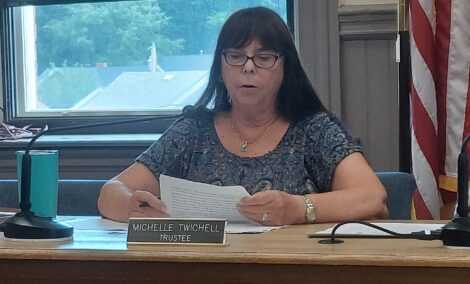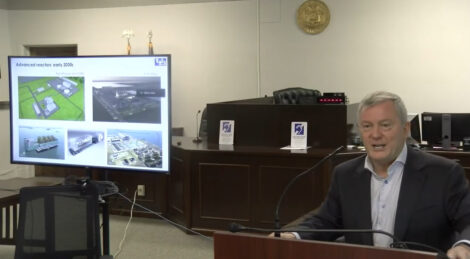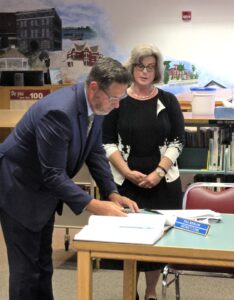‘Informed Thought’
Expert Talks Nuclear To City Crowd

Andrew Whitaker speaks during a Dunkirk community discussion about nuclear power.
DUNKIRK — The keynote speaker at Dunkirk Mayor Kate Wdowiasz’s “nuclear summit” for the community tried to clear up misconceptions about the energy source.
University of Buffalo professor Andrew Whitaker is “a nationally recognized expert in nuclear engineering and structural safety standards,” Wdowiasz said in her introduction. “He has played a key role in shaping modern nuclear power.”
“My goal is to provide you with informed thought, let me say,” Whitaker told a crowd of about 60 in the Dunkirk City Hall council chamber. “I have no skin in the game in terms of different reactor technologies. I work with a number of reactor developers, so I’m familiar with what’s coming online, when it’s coming online.”
Wdowiasz called the meeting in response to Gov. Kathy Hochul’s recent announcement that she wants to put a new nuclear power plant in upstate New York. The mayor and local planning officials want Hochul to consider the mothballed NRG plant as a site for the facility.
Whitaker said, “The reactors that are coming online in the next 10 to 15 years — not my grandfather’s nuclear reactors from the 1960s and 1970s. Designs have changed fundamentally, indeed in the last 20 years.”
He spent time debunking what could be called “the Homer Simpson effect” — the possible misconceptions provided through the comical “Simpsons” character, a nuclear reactor engineer. Whitaker noted a clip where Homer “had taken the top off a 44-gallon drum of green goo and it was labeled nuclear fuel and he was having it for lunch… Nuclear fuel’s not green, and when we move nuclear fuel around, it’s not in a 44 gallon drum, it’s in a 50 to 100 ton canister with reinforced concrete and steel.”
He said nuclear engineers “are highly trained. … They’re talented folks who take their job very seriously and they’re trained over a number of years.”
Whitaker continued, “I’m not advocating for 100% nuclear energy. It would not be a cost efficient pathway to deliver electricity here in the United States. In my opinion, it needs to be part of the energy mix. What that percentage is depends on how you measure the power — but somewhere between perhaps 30 to 40%, given that we’re not going to grow hydro, and I think long-term the nation will move away slowly from natural gas, and it’s moving away from coal fairly quickly.”
Whitaker offered an interesting tidbit about wind and solar power, an option heavily promoted by the state: it was delivering just 2% of the state’s power on Monday.
There are currently 94 nuclear reactors operating across the United States, which Whitaker called “deep bench depth.” Upstate New York already has a nuclear power plant, in Oswego.
Whitaker went on to explain how a nuclear plant works and discuss some of the challenges of nuclear energy. He said building a nuclear reactor costs about $13 billion. However, he stated, “You spend 50-60% of that $13 billion on civil construction. That’s money spent on site, where you’re building the plant. So if you’re going to spend $13 billion on a plant here in Dunkirk, and you make that decision, you’re going to spend $7.5 billion of that here. That’s a shot in the arm for any community.”
Whitaker downplayed some famous nuclear accidents. Chernobyl “was a Soviet era weapons production facility. … It looked nothing like a Western reactor. It didn’t have a containment structure, which had been routine on U.S. reactors since the 1950s.” He said it was an accident not directly applicable to the U.S.
As for the Three Mile Island incident, he noted no one died and it was caused by operator error, “which borned an engineering discipline that addressed how humans operate or collaborate with complex equipment.”
Whitaker said of the most recent event, the Fukushima disaster in 2011, “Yes, it was an accident, and it’s going to cost a lot of money to clean up. But no one died.” Those reactors also didn’t have safety retrofits required in the U.S., he added.
Moving on, Whitaker described the difference between various sizes of nuclear reactors, and the ways they are fueled. The most state-of-the-art reactors won’t be available until 2030.
He noted that many modern reactors do not need water as a coolant, using chemicals and metals instead. Deciding what fuel to use is an important part of the plant siting process, he added.
Whitaker concluded by touting the high-paid union jobs that would come with the construction of a nuclear power plant, and that the plant could provide jobs for up to the next 80 years.





